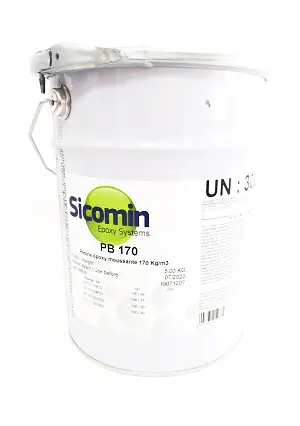Product Description
EPOXY FOAM 170 5 KG, RESIN COMPONENT 170 KG/M3
Epoxy foam expands more slowly than urethane and offers excellent adhesion to almost all materials. In addition, it has very low water absorption. Typical applications include, for example, a boat’s keel or rudder, filling voids when manufacturing sandwich laminates, and repairs of sandwich laminates, among others.
The foam is available in 170 kg/m³ and 250 kg/m³ grades, with two different hardeners. The slow hardener is especially recommended for thicker castings to prevent excessive reaction heat (e.g., > 50 mm). Epoxy foam is also available in larger quantities as a three-component system, where the third component allows you to adjust the foam density yourself. We are happy to provide more information.
Mix ratio: | |
170 kg/m3 5 kg + standard hardener 1,55 kg | 100 : 31 |
1700 kg/m3 5 kg + slow hardener 1,8 kg | 100 : 36 |
Epoxy foam is also available in larger containers.
Usage
1. Measure the volume to be filled, which will allow you to calculate the correct amount of mixture.
2. Mix both components separately first to eliminate any separation of raw materials that may have occurred during storage.
3. Measure the correct component amounts carefully according to the mix ratio, using for example a precise scale or a medical syringe.
4. Thoroughly mix the components together, scraping the bottom and sides with the mixing stick. The mixture must be poured within a maximum of 4 minutes.
To help remove excess bubbles caused by mixing, pour the mixture into the foaming area through a sieve. This helps achieve the most homogeneous foam possible.
Epoxy foam expands relatively quickly, but curing takes several hours. Once cured, the foam is hard but relatively brittle. Final hardness and toughness develop only over time. The best way to treat epoxy foam—just like epoxy resins in general—is to post-cure the foam after room temperature curing, for example at 40°C for 6 hours (e.g., overnight in a sauna). After post-curing, the result is a strong, water-resistant structure that endures.
Safety
Before handling epoxy, ALWAYS ensure good ventilation and proper skin protection. Wear a long-sleeved shirt and disposable gloves resistant to epoxy (e.g., nitrile rubber). Uncured epoxy resin is a strong skin sensitizer. A suitable respirator for working with epoxy is classified according to EN405. Fully cured epoxy resin is not hazardous to health.
Tools can be cleaned with acetone, but keep in mind that epoxy is a very strong adhesive and sticks to almost anything – including your tools. Therefore, use inexpensive tools that can be discarded after use.
Hardener
Harmful if swallowed or in contact with skin. Causes severe skin burns and serious eye damage. May cause an allergic skin reaction. May cause damage to organs through prolonged or repeated exposure (if swallowed). Toxic to aquatic life with long lasting effects.
Resin
Causes skin irritation. May cause an allergic skin reaction. Causes serious eye irritation. Toxic to aquatic life with long lasting effects.


